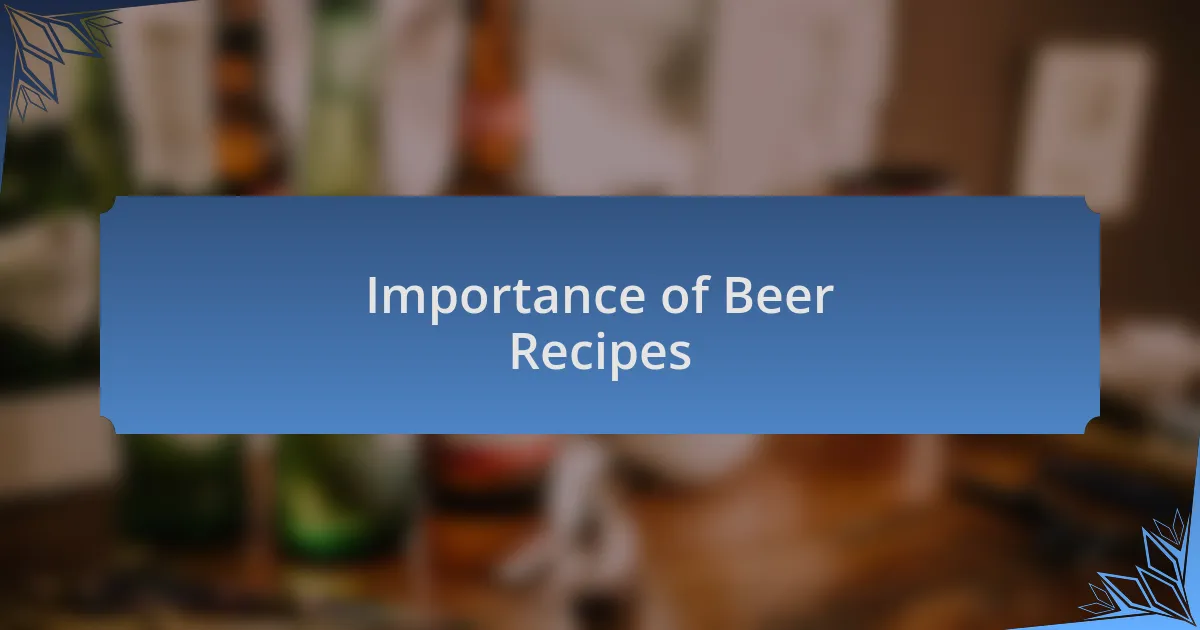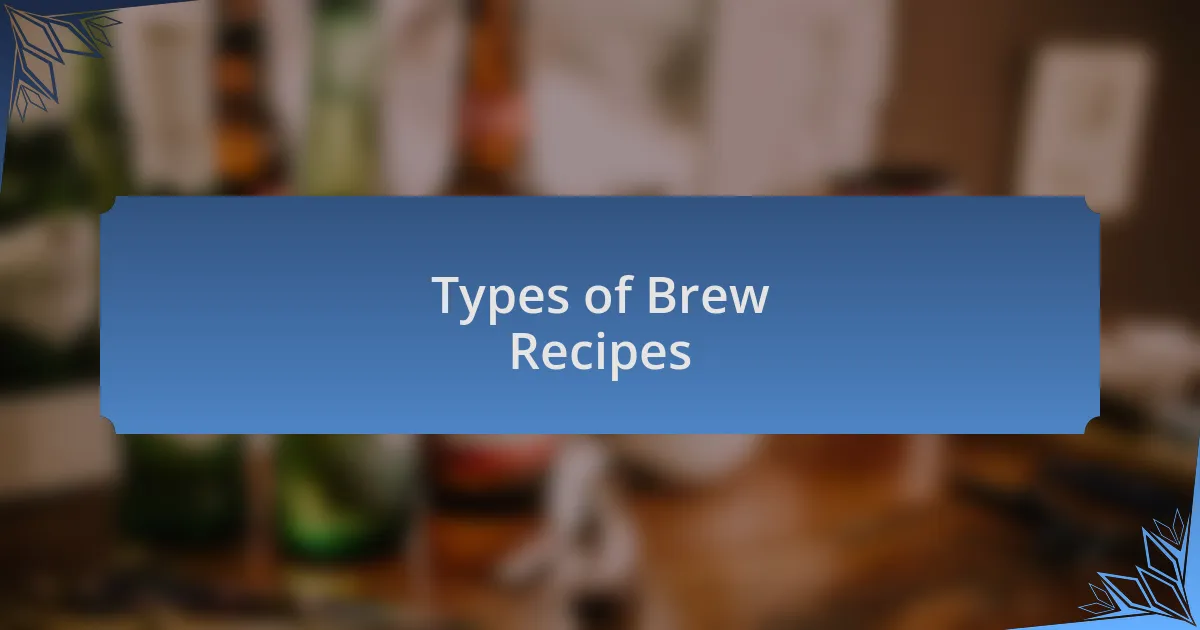Key takeaways:
- Craft Beer Festivals celebrate local brewers and offer unique flavors, fostering community and camaraderie among attendees.
- Beer recipes serve as essential guides for crafting brews, allowing for creativity and personal touches that enhance the brewing experience.
- Selecting ingredients, particularly malts and hops, significantly influences the flavor profile of the beer, making the choice an intimate part of the brewing journey.
- Pairing beer with food can enhance both, creating memorable culinary experiences that bring people together.

What is Craft Beer Festival
A Craft Beer Festival is much more than a simple gathering; it’s a vibrant celebration of creativity and passion for brewing. It’s where local brewers come together to showcase their finest creations, offering attendees the chance to sample unique flavors that reflect their regions. Have you ever wandered through a festival and stumbled upon a surprising flavor combination? Those moments are what make craft beer festivals truly special.
At these events, the atmosphere is electric, buzzing with excitement and camaraderie among fellow beer lovers. I vividly remember my first craft beer festival; the air was filled with laughter and the clinking of glasses as new friends shared their favorites. It’s fascinating how a single drink can spark such engaging conversations and create lasting memories with fellow brewers and enthusiasts alike.
What makes craft beer festivals particularly intriguing is the opportunity to connect directly with the creators behind the brews. I recall chatting with a brewer who passionately described the inspiration behind a sour ale, transforming my appreciation for beer. It’s moments like these, where stories blend with flavors, that truly highlight why craft beer festivals are a treasure trove of experiences waiting to be explored.

Importance of Beer Recipes
Beer recipes are the backbone of every craft brew, serving as a roadmap for creativity and experimentation. Every ingredient plays a crucial role, influencing flavors, aromas, and even the brewing process. Think about the first time you tried a complex stout—didn’t it make you wonder about the careful selection of malts and hops that created those layers of taste?
When I first delved into brewing, I was amazed by how a simple recipe could evolve into something extraordinary. I remember tweaking a basic pale ale recipe by adding unexpected spices, leading to a delightful blend that surprised my friends. It highlighted for me that the recipes not only guide the brew but also invite personal touches that can elevate an ordinary beer into a memorable experience.
Moreover, sharing beer recipes fosters community among brewers and enthusiasts. At a recent festival, I connected with a fellow brewer who generously shared his secret recipe for a luscious raspberry wheat beer. It was a fantastic reminder of how these recipes break barriers and create bonds, linking us through shared experiences and flavors that seem to unify us, don’t you think?

Types of Brew Recipes
When it comes to brew recipes, there’s a world of variety to explore. For instance, I’ve always had a soft spot for IPAs, particularly West Coast styles with their intense hop profiles. The process of balancing bitterness with fruity notes can be a real delight, almost like painting on a canvas. Have you ever thought about how those aromatic qualities can transform an ordinary day into something special?
Then there’s the charm of sour beers. My first sip of a Berliner Weisse transported me to a summer festival filled with laughter and sunshine. The tartness and refreshing nature of that brew opened my eyes to the beauty of fermentation techniques like kettle souring. It made me realize that there’s a whole universe of flavors waiting when you embrace wild yeast and bacteria.
And let’s not forget about stouts! I have an absolute love for oatmeal stouts — the rich, creamy texture appeals to my taste buds like nothing else. I vividly remember brewing one with a hint of coffee, and how it created a velvety mouthfeel that enveloped me in warmth during a chilly evening. It’s moments like these that truly showcase the versatility and depth of craft beer recipes, don’t you agree?

Choosing Ingredients for Brewing
Choosing the right ingredients for brewing is a journey that feels intimate and personal. I remember my first experience shopping at a local homebrew store, surrounded by the myriad of malts, hops, and yeasts. Each bag seemed to whisper promises of unique flavors and aromas, inviting me to experiment and discover what I truly enjoyed. Have you ever felt that rush of excitement when selecting grains for a new recipe?
Malt selection can significantly influence the character of your brew. For instance, I once incorporated a chocolate malt into a brown ale, which elevated its complexity and delivered an irresistible richness. The outcome was a warm, comforting brew that felt like a hug on a cold day. Reflecting on that experience made me realize just how critical these choices are in crafting something memorable.
Hops, on the other hand, are like the vibrant colors in a painting. They bring out aromas that can transport you to different places; I often think of the floral notes from Cascade hops as reminiscent of a blooming garden. Choosing hops is not merely about bitterness; it’s about weaving together the bouquet of scents that’ll dance on your palate. What hops will you experiment with in your next brew to create your own masterpiece?

My Top Brew Recipes
I find that my go-to recipe for a pale ale always strikes the perfect balance of hops and malt. Using amarillo hops infuses the beer with citrus-like aromas that bring a refreshing brightness. I vividly recall savoring my first sip after a long day; it felt like the sun was shining directly into my glass. Have you ever tasted a brew that just lifted your spirits instantly?
For a rich stout, I often turn to a blend of roasted barley and oats. One evening, I decided to add a touch of coffee during the brewing process, creating a brew that was bold and invigorating—a true representation of comfort in a bottle. Each time I pour it, that familiar coffee aroma takes me back to cozy evenings spent by the fireplace, enjoying good company. What unexpected ingredient would you consider adding to your brew for a unique twist?
Another favorite of mine is a saison that combines spicy Belgian yeast with a hint of orange zest. The moment I released the first batch, I was transported to a sunny afternoon in a European garden. It’s a joyful experience to share this brew with friends, as its effervescent quality always sparks lively conversations. What stories would your favorite recipe tell if it could speak?

Pairing Brews with Food
When it comes to pairing brews with food, I find that the right combination can elevate both the dish and the beer. For instance, a smoky porter alongside BBQ ribs creates a beautiful harmony; the dark, rich flavors of the porter cut through the sweetness of the glaze, making each bite as pleasurable as the last sip. Have you ever noticed how a well-paired beer can enhance the taste of a meal?
One evening, I hosted a gathering where I matched an IPA with spicy tacos. The hoppy bitterness of the beer beautifully contrasted the bold flavors of the spices. My friends couldn’t get enough of this pairing, and I felt an immense sense of satisfaction watching them savor each bite and sip. Isn’t it amazing how the right brew can bring people together over a shared culinary experience?
A personal favorite of mine is pairing a light wheat beer with a fresh citrus salad. The beer’s zesty profile complements the salad’s tangy notes, creating a refreshing experience that feels perfect on a warm day. I still remember enjoying this combination on a sunny terrace, where every sip seemed to enhance the vibrant colors of the dish. What unique pairings have you discovered that made you see food in a new light?

Tips for Sharing Recipes
When sharing my brew recipes, I always start by highlighting the unique aspects that make each one special. For example, I describe not just the ingredients but also the story behind why I chose a particular flavor combination. This personal touch invites others into my brewing journey, making them feel part of the experience. Have you ever shared a recipe that sparked a conversation around its backstory?
I also find it effective to provide tips on how others can customize the recipes to suit their tastes. Encouraging variations opens up a creative dialogue. One time, I suggested using different hops in a pale ale recipe to friends who preferred a more fruity note, and they ended up creating their own signature brew. Isn’t it exciting to see how a small tweak can transform a familiar recipe?
Lastly, I make sure to share not only recipes but also the brewing process and the “why” behind each step. Explaining techniques helps others understand and appreciate the craft. I still remember the exhilaration of teaching someone to brew for the first time; their eyes lit up when they realized they could create something completely unique. What have you learned while helping someone else discover the joys of brewing?